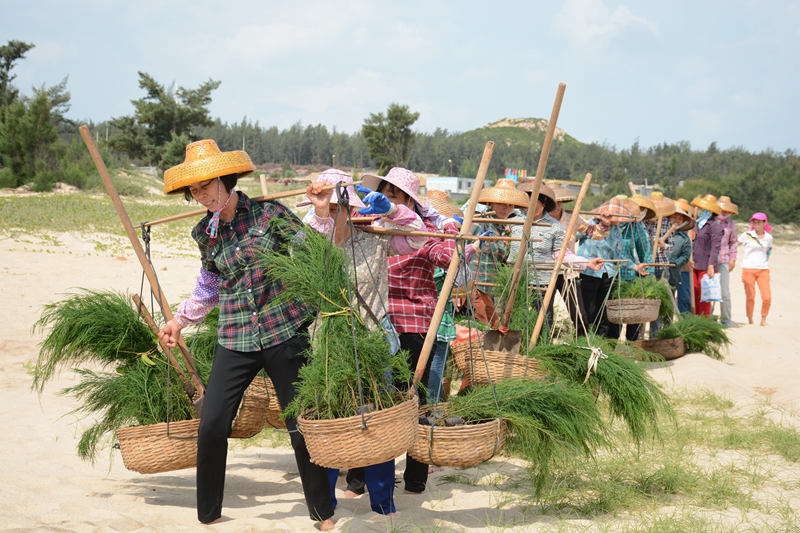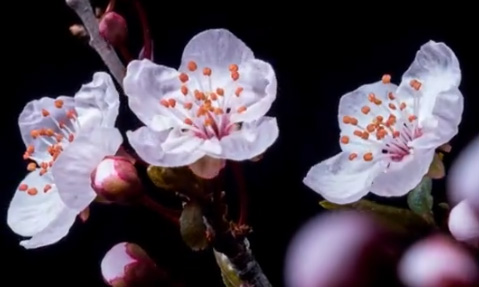Indefatigable team of women transform barren coastal area of Hainan with largescale tree-planting efforts

Photo shows Tao Fengjiao and women in her community carrying saplings on their shoulders and walking barefoot across the scorching sand in Qizi Bay, Changjiang Li Autonomous County in south China’s Hainan Province. (Photo courtesy of the Media Convergence Center of Changjiang Li Autonomous County)
Over the past three decades, Tao Fengjiao and more than 100 women have together planted around 6 million casuarina trees in barren desert areas on a beach and cultivated some 33,800 mu (about 2,253 hectares) of coastal forests in the Changjiang Li Autonomous County of south China’s Hainan Province.
Changjiang Li Autonomous County, located in the southwestern coastal area of Hainan, used to be severely affected by desertification. During the eight-month dry season every year, the amount of evaporation is twice as much as the amount of precipitation in Changjiang.
Qizi Bay, located in Changhua township under the jurisdiction of Changjiang Li Autonomous County, has faced a more severe situation as the annual level of precipitation there is normally just around 700 millimeters. The long and narrow desert area, consisting of 5,030 mu of terrain with moving sands and more than 13,000 mu of terrain with semi-moving sands, has negatively impacted the production and living conditions of local residents.
In the 1970s, forestry departments at various levels in Hainan Province took multiple measures to plant more trees in order to fix the sand in place at Qizi Bay, but their efforts failed to pay off in the end. The provincial forestry department of Hainan even invited two German experts to help, but they both thought the sand was “uncontrollable.”
In 1992, a businessman took over the coastal forest construction project in Qizi Bay. He hired locals to plant trees and paid them 7 yuan ($1.099) per person, per day. However, the project ended up going nowhere and the businessman eventually had to give up on the project.
Tao, who joined the project with the original intention of making a living, together with other women in her village, undertook the tree-planting job with great courage.

Photo shows Tao Fengjiao and women in her community carrying saplings on their shoulders and walking barefoot across the scorching sand in Qizi Bay, Changjiang Li Autonomous County in south China’s Hainan Province. (Photo courtesy of the Media Convergence Center of Changjiang Li Autonomous County)
The female tree-planting team explored a very simple method to plant trees—they first collected tree seeds by hand from the trees, and then planted the seeds and cultivated them until they grew into saplings. After having tried and failed multiple times, they finally succeeded in cultivating saplings that could survive the harsh local conditions.
Each of the women had to carry about 65 kg of saplings on their shoulders and walk barefoot across the scorching sand, while some of them even carried more than 130 kg of saplings per trip in an attempt to improve their efficiency.
Due to the heavy workload, the female planters were often soaked in sweat, while their shoulders were in pain due to the heavy loads they carried, having also gotten calluses on their feet. However, Tao and most of the women never flinched in front of all the difficulties.
The efforts of the female planters finally paid off. Over the past 30 years, these women not only planted around 6 million casuarina trees but also cultivated some 33,800 mu (about 2,253 hectares) of coastal forests in the sandy areas around Qizi Bay, where the mortality rate for trees planted there was once as high as 99 percent.
An official from the forestry department of Changjiang Li Autonomous County introduced that in 2010, the total protected area for coastal forests in the county was more than 52,000 mu, with over 36 percent of the trees having been planted by Tao and other female planters.
Tao has been awarded many honorary titles because of her contributions to the cause of sand control.
“I planted trees to make a living in the first place, and gradually I realized that in addition to planting trees, I also wanted to protect them. Seeing that the sandy areas have turned into an oasis, I feel really happy,” said Tao. “I’ll keep doing this as long as my health permits,” the woman said.

Photo shows Tao Fengjiao and women in her community carrying saplings on their shoulders and walking barefoot across the scorching sand in Qizi Bay, Changjiang Li Autonomous County in south China’s Hainan Province. (Photo courtesy of the Media Convergence Center of Changjiang Li Autonomous County)
Photos
Related Stories
- Four years on, Hainan presents new image
- Botany teacher devotes himself to protection of wetland home for waterfowl species in Hainan
- Emancipate mind, strive for innovation, work hard together to accelerate the construction of Hainan Free Trade Port: Xi
- Yazhou Bay Seed Laboratory in Sanya, S China's Hainan
- Hainan's tropical rainforest park a highlight of national ecological progress
- Fishermen of south China's Hainan greet late spring season with bountiful catch
- Newborn rare gibbon spotted in Hainan national park
- Hainan's Maona Village promotes rural tourism to increase locals' incomes, expedite rural revitalization
- Xi stresses boosting national park development in Hainan
- Xi inspects Wuzhishan in Hainan
Copyright © 2022 People's Daily Online. All Rights Reserved.










